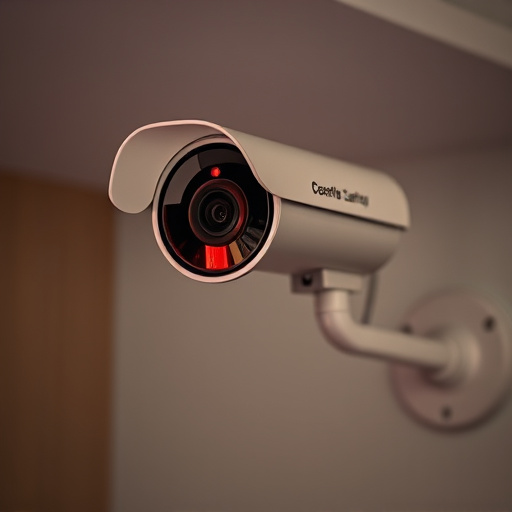Strategically placing realistic fake security cameras in visible areas like entryways, windows, and exterior walls acts as a powerful deterrent against crime. The best placement ensures maximum visibility at common approach points, enhancing security without needing a functional system. For residential areas, place them near windows or doors; in commercial settings, align them with entry points, hallways, and high-traffic zones at eye level or slightly elevated for realism. Regular maintenance and adjustments ensure optimal performance, maximizing the security benefits of these decoy cameras.
“Uncover the power of fake security camera mounting brackets—a discreet and cost-effective way to enhance home or business security. This comprehensive guide explores the benefits of these innovative devices, offering a layer of protection without breaking the bank. We’ll delve into key factors for optimal placement, from choosing the best spots to avoid detection to ensuring maximum coverage. Discover popular installation areas and learn valuable tips to steer clear of common pitfalls, making your fake cameras as effective as possible.”
- Understanding Fake Security Cameras and Their Benefits
- Key Factors to Consider for Optimal Placement
- Popular Areas for Discreet Surveillance
- Installation Tips and Common Pitfalls to Avoid
Understanding Fake Security Cameras and Their Benefits
Fake security cameras, also known as decoy or dummy cameras, are an innovative way to enhance home and business security while offering several advantages. These devices mimic real security systems, providing a powerful psychological deterrent against potential intruders. By strategically placing fake cameras, you can create the illusion of a fully functional surveillance system, significantly reducing the risk of crime.
The best placement for fake security cameras is often in highly visible areas where they can serve as a constant reminder to trespassers. Common spots include entryways, windows, and exterior walls. These locations are easily accessible and provide clear lines of sight, making them ideal for deterring would-be thieves or vandals. Additionally, mounting these brackets at an angle that faces common approach points ensures maximum visibility, further enhancing their effectiveness as a security measure.
Key Factors to Consider for Optimal Placement
When determining the best placement for fake security cameras, several key factors should guide your decision to ensure optimal effectiveness and realism. First, consider the environment where you plan to install them. The surroundings play a crucial role in making the camera placements seem natural and unsuspicious. For instance, if targeting a residential area, place the brackets near windows or doors, mimicking common security practices. In commercial settings, aligning the cameras with entry points, hallways, and high-traffic zones can enhance their credibility.
Additionally, the placement should consider field of view (FOV) to capture comprehensive footage. Ensure the camera’s angle covers essential areas without overlapping, allowing for clear surveillance. The height at which you mount the brackets matters; securing them at eye level or slightly elevated positions mirrors professional security setups. Moreover, accessibility for maintenance and adjustments is vital, so choose locations that offer easy reach but remain discreet.
Popular Areas for Discreet Surveillance
In choosing the best placement for fake security cameras, discretion is key. Popular areas for discreet surveillance include entry and exit points like doors, windows, and gates. Strategically placing these faux cameras near high-traffic zones or valuable assets can deter potential intruders effectively. Overlooking alleyways, backdoors, and dark corners can significantly enhance home or business security without drawing unnecessary attention.
Additionally, fake security camera mounting brackets can be used in common areas such as parking lots, outdoor seating arrangements, and walkways to create a sense of surveillance, thereby discouraging vandalism or unauthorized access. The key is to mimic the look and feel of genuine security equipment while maintaining an aura of subtlety—the best placement ensures maximum deterrence with minimal visibility.
Installation Tips and Common Pitfalls to Avoid
When installing fake security cameras, ensuring proper placement is key to enhancing home or business security. The best location for these decoys is often in plain sight, offering a visual deterrent to potential intruders. Mount them on walls, fences, or structures with good visibility, avoiding areas easily blocked by trees or other obstructions. Close proximity to entry points like doors and windows is ideal, as it can discourage unauthorized access.
Common installation pitfalls include poor positioning, where the camera’s field of view is obstructed or doesn’t cover crucial areas. Another avoidable mistake is not ensuring the bracket’s stability; loose or shaky mounts can reduce the overall effectiveness and may even alert a would-be thief to its fake nature. Always secure brackets firmly, and consider testing the setup to confirm it isn’t easily dislodged. Additionally, regular maintenance and periodic adjustments are recommended to keep them in optimal working condition and aligned with the best placement strategies for maximum security benefits.
Fake security camera mounting brackets offer a discreet and cost-effective way to enhance home or business security. By understanding the benefits, key placement factors, popular surveillance areas, and installation tips, you can maximize their effectiveness. Remember, the best placement for fake security cameras is where they provide a genuine deterrent without compromising aesthetics. With proper positioning, these devices can serve as a reliable and affordable security solution, offering peace of mind in today’s digital era.
